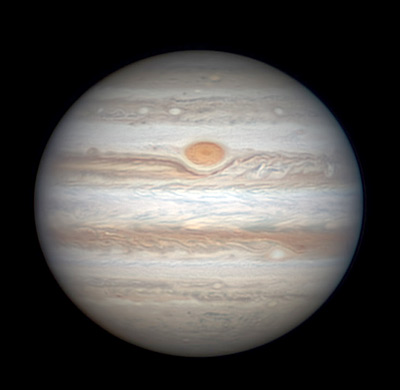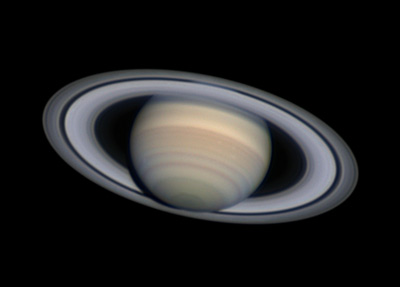This Week’s Sky at a Glance, April 15 – 23
Comet 252P/LINEAR is still hanging in there, crossing Ophiuchus very high before the first light of dawn. It was still 6th magnitude as of April 10th: a big, dim glow in binoculars. See our current article and chart.

Waxing and moving eastward, the Moon hangs down like an ornament from the Leo's Sickle on Saturday evening the 16th.
Friday, April 15
• The Moon this evening forms a gently curving row with, to its left, Regulus and then bright Jupiter, as shown at right.
Saturday, April 16
• Look above the Moon after dusk for Regulus, the bottom of the now-vertical Sickle of Leo. They're separated by about 3° (for the Americas), about two finger-widths at arm's length.
Sunday, April 17
• That bright "star" close by the Moon this evening is Jupiter. Although they look close together, Jupiter is currently 1,760 times farther away. And it's 40 times larger in diameter.
Monday, April 18
• This is the time of year when, as twilight fades, the dim Little Dipper extends straight to the right from Polaris in the north. Very high above the end-stars of the Little Dipper's bowl, you'll find the end-stars of the Big Dipper's bowl.
Tuesday, April 19
• Bright Arcturus is climbing high in the east these evenings. Equally bright Capella is descending high in the northwest. They stand at exactly the same height above your horizon sometime between about 8:30 and 10:00 p.m. daylight-saving time, depending mostly on how far east or west you live in your time zone.
Wednesday, April 20
• The almost-full Moon hangs about 6° above Spica low in the southeast in twilight (for North America). Watch the Moon edge a little closer to Spica through the night.
Thursday, April 21
• Full Moon tonight (exact at 1:24 a.m. Friday morning Eastern Daylight Time). The Moon shines in Virgo this evening, with Spica to its upper right and brighter Arcturus three times farther to its upper left.
Friday, April 22
• As night descends, look high in the west for Pollux and Castor lined up almost horizontally (depending on your latitude). Pollux and Castor, the heads of the now-almost-upright Gemini twins, form the top of the enormous Arch of Spring. The two ends of the Arch are Procyon to their lower left, and brighter Capella farther to their lower right. The whole thing sinks in the west through the evening.
Saturday, April 23
• Arcturus is the brightest star in the east these evenings. Spica shines about three fists at arm's length to its lower right. To the right of Spica by half that distance is the distinctive four-star constellation Corvus, the Crow of Spring.
_________________________
Want to become a better astronomer? Learn your way around the constellations. They're the key to locating everything fainter and deeper to hunt with binoculars or a telescope.
This is an outdoor nature hobby. For an easy-to-use constellation guide covering the whole evening sky, use the big monthly map in the center of each issue of Sky & Telescope, the essential guide to astronomy.

The Pocket Sky Atlas plots 30,796 stars to magnitude 7.6 — which may sound like a lot, but it's less than one per square degree on the sky. Also plotted are many hundreds of telescopic galaxies, star clusters, and nebulae. Shown above is the new Jumbo Edition for easier reading in the night. Click image for larger view.
Once you get a telescope, to put it to good use you'll need a detailed, large-scale sky atlas (set of charts). The basic standard is the Pocket Sky Atlas (in either the original or new Jumbo Edition), which shows stars to magnitude 7.6.
Next up is the larger and deeper Sky Atlas 2000.0, plotting stars to magnitude 8.5, nearly three times as many. The next up, once you know your way around, is the even larger Uranometria 2000.0 (stars to magnitude 9.75). And read how to use sky charts with a telescope.
You'll also want a good deep-sky guidebook, such as Sue French's Deep-Sky Wonders collection (which includes its own charts), Sky Atlas 2000.0 Companion by Strong and Sinnott, or the bigger Night Sky Observer's Guide by Kepple and Sanner.
Can a computerized telescope replace charts? Not for beginners, I don't think, and not on mounts and tripods that are less than top-quality mechanically (meaning heavy and expensive). And as Terence Dickinson and Alan Dyer say in their Backyard Astronomer's Guide, "A full appreciation of the universe cannot come without developing the skills to find things in the sky and understanding how the sky works. This knowledge comes only by spending time under the stars with star maps in hand."
This Week's Planet Roundup

Mars on March 23rd, imaged by Christopher Gowith a 14-inch scope. South is up. The big white patch at top is not the South Polar Cap or South Polar Cloud Hood but the Hellas basin, which often fills with clouds or frost. The now-small North Polar cap is at bottom. The big dark peninsula at center is Syrtis Major; Hellas is due south of this landmark. Extending to the right-hand limb (celestial east; following ) is thinner Sinus Sabaeus ending with Sinus Meridiani. The dark arc just inside the entire bright limb is a processing artifact. Watch out for these "echoing" bright/dark borders in planetary images.

Jupiter's Great Red Spot is still strikingly red. Christopher Go took this image at 16:45 March 5th UT, just a few minutes before the spot reached the central meridian. South is up. Notice the smooth vs. turbulent difference in the South Equatorial Belt preceding (left) and following the Red Spot.

Saturn's rings are wide open this season, tipped 26° to our line of sight and extending above the planet's north and south poles. Damian Peach took this extraordinarily fine stacked-video image with a 14-inch scope on March 19, 2016. South is up. "Superb seeing conditions," he writes. "Only a few small spots are visible but the view was wonderful at 400x. I continued until the sun came up!"
The Sun is displaying an unusually big spot, visible with no magnification — just a safe solar filter or a #13 or #14 rectangular arc-welder's filter. As of Friday April 15th the spot, designated AR [Active Region] 2529, had just passed the Sun's central meridian. It should remain visible for not quite a week, until it rotates around the Sun's western limb.
Mercury remains well-placed low in the west-northwest in twilight, but it's fading fast: from magnitude –0.3 on Friday the 15th to +0.9 on Friday the 22nd.
Venus is hidden in the glare of sunrise.
Mars (about magnitude –1.0, in the legs of Ophiuchus above Scorpius), rises around 11 p.m. daylight-saving time and blazes highest in the south before the first light of dawn, to the right of dimmer Saturn and above Antares. In a telescope Mars grows this week from 14 to 15 arcseconds in diameter. See our telescopic Mars guide in the April issue of Sky & Telescope, page 48.
At its closest approach to Earth in late May, Mars will grow to 18.6 arcseconds wide.
Jupiter (magnitude –2.3, in southern Leo) dominates the southern sky these evenings. Nothing else is nearly so bright! See our telescopic guide to Jupiter in the March issue of Sky & Telescope, page 48.
Saturn (magnitude +0.3, also in the legs of Ophiuchus above Scorpius) rises around midnight 7° to the lower left of brighter, more colorful Mars. By early dawn they stand in the south-southwest — Saturn on the left, bright Mars on the right. Fainter, Mars-colored Antares beneath Mars makes it a triangle.
Uranus and Neptune are masked by the glow of sunrise. Wait till later in the year.
__________________________
All descriptions that relate to your horizon — including the words up, down, right, and left — are written for the world's mid-northern latitudes. Descriptions that also depend on longitude (mainly Moon positions) are for North America.
Eastern Daylight Time (EDT) is Universal Time (UT, UTC, or GMT) minus 4 hours.
__________________________
“This adventure is made possible by generations of searchers strictly adhering to a simple set of rules. Test ideas by experiments and observations. Build on those ideas that pass the test. Reject the ones that fail. Follow the evidence wherever it leads, and question everything. Accept these terms, and the cosmos is yours.”
— Neil deGrasse Tyson
No comments:
Post a Comment